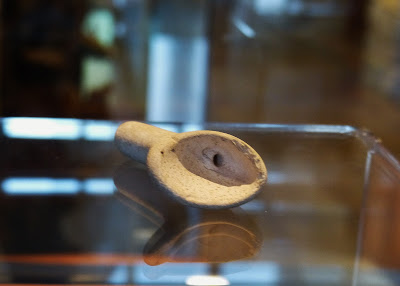Specimen of the Month: The Natural History of a Clay Pipe
The novel habit of tobacco smoking was not approved of by religious leaders in the New World, but that didn’t stop people from smoking.
A single clay pipe specimen at the Museum speaks to the history of human cultures in this area as well as many other societies. Pipes of this nature were generally used to smoke tobacco for recreational, medicinal, and within indigenous communities, ceremonial purposes. While this particular pipe is likely French made, clay pipes are indigenous American in origin.
 |
| This clay pipe is of a simple design. It was found on the shore of Lake Superior just north of the town of Brule, WI. The specimen can be found on display through the month of October. |
Various tribes in the Americas had already been designing smoking pipes out of clay for ages. Smoking took place largely as a ceremonial end to meals or as a medicine, but with time and changes within individual societies, it became a common habit among many. The most familiar plant used to smoke by western tribes were species of native tobaccos (often Nicotiana attenuata or Nicotiana rustica). Herbal mixtures of various dried plants, often called "kinnikinnick," were smoked too. Common ingredients included the dried leaves or barks of tobaccos, bearberry, sumacs, red osier dogwood, and American wahoo, among various others.
 |
| Falcon effigy pipe made of black steatite by Mississippian cultures. Image property of Brooklyn Museum. |
Europeans quickly took up smoking too after tobacco and potato plants were first brought back from the Americas. Tobacco was promptly favored, potatoes not so much. They further began using clay pipes similar to those which they had observed being used by indigenous Americans. At first the religious and political leaders of England and beyond persecuted their people for smoking. Soon, though, it quickly grew to be quite a popular trend among Europeans and colonizers in America.
The manufacture of clay pipes in Europe became a natural necessity for a growing vice. A white, fine-grained clay appropriately called "pipe clay" was often used for pipe making, although meerschaum and then briarwood became more popular options. Smokers valued clay for its ability to filter tobacco smoke in such a way that excess juices were absorbed and odors were minimized. But no matter the material, pipes became an art form too.
 |
| English clay pipes and pipe bowls. Image property of The Herb Museum. |
Designers across Europe, including England, France, and Germany, created intricate designs with geometric patterns or in the form of plants, animals, and humans as had been done by ancient Americans. They became pieces of art more than an instrument. Sometimes, though, they just wanted a simple pipe for functional purposes.
Although this clay pipe specimen is a relic of times ago, smoking pipes are still appreciated or even used today by a faction of smokers, collectors, and museum curators alike.
